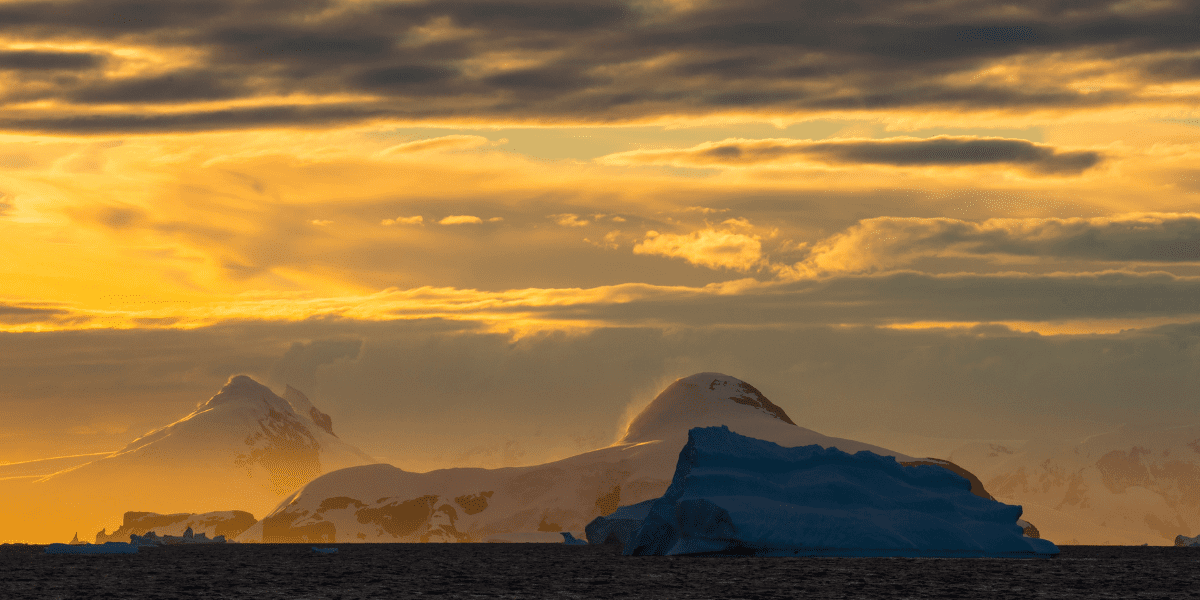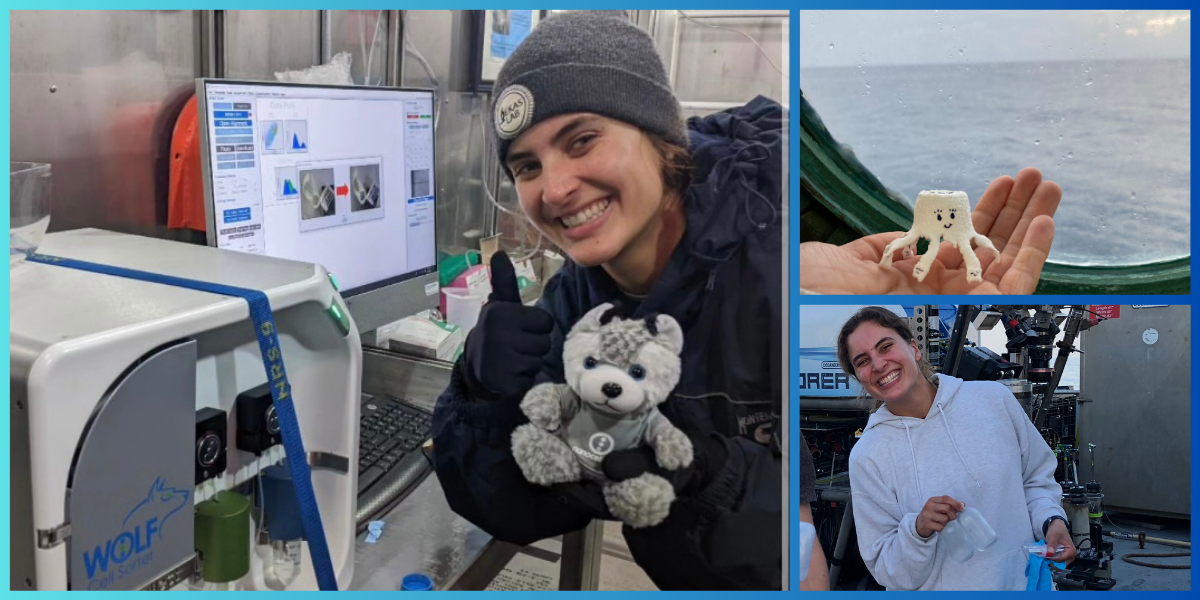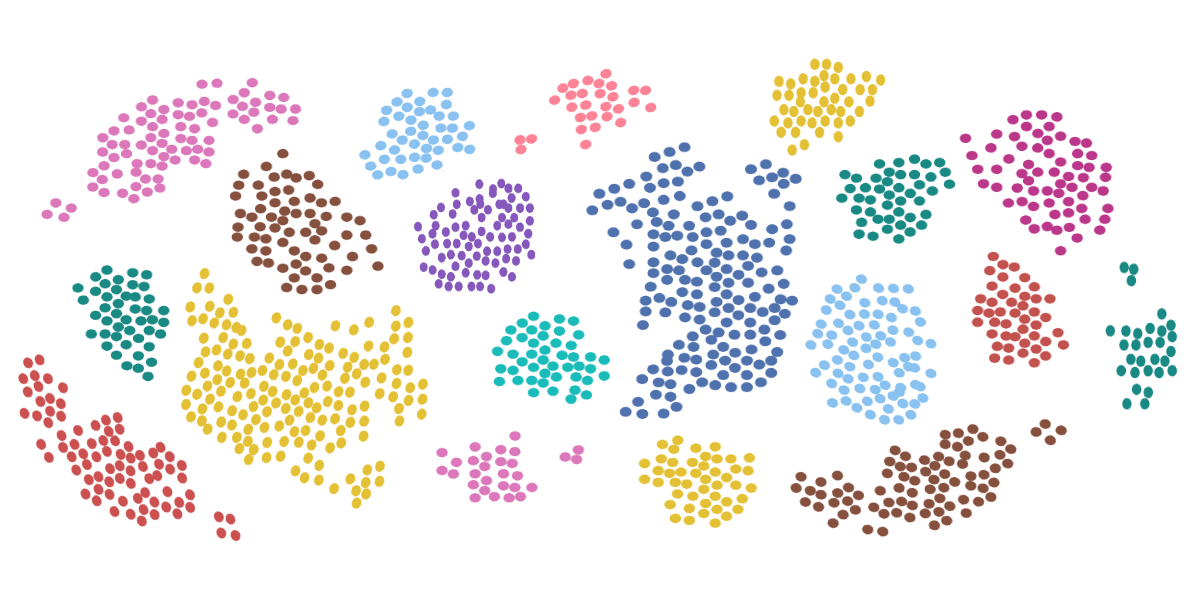Cell Sorting in Antarctica: Unlocking Microbial Mysteries of Earth’s Carbon Cycle

In the midst of Earth’s most tumultuous stretch of ocean, waves rise like towering walls of roaring water. The air is laden with the briny tang of salty seawater and a whipping wind that chills to the bone. Your ship sways to the rhythm of the ocean’s roll as it cuts through boundless waters that stretch as far as the eye can see, inspiring equal parts awe and trepidation.
This is no tropical cruise. This is the Drake Passage, the daunting 500-mile (800-kilometer) stretch of open ocean you must cross to reach Antarctica.
Scientist Elizabeth “Beth” Connors’ path to this extraordinary encounter was a journey. One fueled by an unrelenting passion for scientific discovery.

Ph.D. student Beth Connors at Palmer Station, Antarctica.
Exploring the Microbial World of Antarctica
Inspired by a love for the outdoors from a young age (she was the kind of kid that went to Birding summer camp), Beth double majored in Marine Biology and Integrative Science at UC Berkley. In the middle of the Atlantic Ocean while working as a research tech with MIT, she got the kind of email prospective Ph.D. students dream of. Dr. Jeff Bowman offered her a spot to research the flow of carbon through bacteria along the Western Antarctic Peninsula.
Dr. Bowman’s lab is part of the Integrative Oceanography Division at the Scripps Institution of Oceanography in San Diego, California. As a marine microecology lab, they use sequence-based approaches, flow cytometry, and other techniques to explore the function of microbial communities in the ocean and understand their role in Earth’s ecosystem.
One area of maximum interest is the Antarctic. Both poles (the North Pole and Antarctica) are warming at a faster rate than anywhere else on the globe, making them Earth’s geographic areas most affected by climate change. The source of global warming is carbon emissions. The warming is accelerated at the poles due to ice loss as a result of those carbon emissions.
“You might not think you’re connected to the Antarctic ecosystem, but you are.” –Beth Connors
If the carbon cycle of Earth’s overall ecosystem is a puzzle, the pieces range from the smallest diatom (think microscopically tiny) to the largest mammals (think whales). It turns out that bacteria (about one-fiftieth the width of a human hair in size) are an important piece of the puzzle.
Bacteria’s Role in Carbon Cycling
Bacteria, minuscule in size and plentiful in number, convert carbon into organic compounds. In an ocean setting, Phytoplankton (called diatoms) trap the inorganic carbon and bacteria process the dissolved organic carbon in the water column. This process prevents the release of carbon into the atmosphere, a win for carbon emissions reduction.
But there are important questions about bacteria’s role in the carbon cycle we don’t yet have answers to. How much carbon goes into the ocean’s bacterium? What happens to it after that?… Does it get consumed by a larger organism? Respired by bacteria as carbon dioxide? Or killed off by a virus?
The influence of bacteria’s carbon transfer in Antarctica remains a knowledge gap in the scientific community. Beth’s research seeks to fill that gap.
The sheer volume of ocean bacteria makes them challenging to study. In just one milliliter (about four drops) of seawater, there are one million bacteria! In a consortium of bacteria that large, it’s difficult to know which ones are respiring, and therefore most pertinent to carbon cycling. (Respiring is a fancy way of saying they are metabolically active, or an even fancier way of saying they are “doing the work” of consuming carbon.)
A way to separate the bacteria that are “doing the work” from those that aren’t, would be incredibly helpful. Could there be a way to identify which ones are respiring? And if you could, could you then isolate those specific bacteria among the myriad of millions?
*Flow cytometry has entered the chat.*
Taking a Cell Sorter to the Field
Beth had an idea. A cell sorter could separate the most relevant species of bacteria from the rest. She just needed to bring one to the field.
If you’re familiar with flow cytometry, you’re probably scratching your head at the practicality of this idea, considering that traditionally, a cell sorter takes up most of a room and requires other bulky items like fluidics carts and customized biosafety hoods. Beth even wrote a paper for a Ph.D. class about her idea and the professor insisted it was impossible.
Undeterred, she began an extensive Google search for innovative cell sorting options and came across the NanoCellect WOLF Cell Sorter. With its compact size and microfluidic technology, the pipe dream of taking a cell sorter to Antarctica became a reality.
With two of her five luggage pieces filled with a WOLF, computer, N1 Single-Cell Dispenser, and plenty of microfluidic cartridges, Beth crossed the Drake Passage and arrived in Antarctica ready to get as much science done as humanly possible during her six-month stay.
It’s not all penguins and snowflakes at the polar opposite of Santa Clause’s workshop. While comradery and scientific spirit abound, researchers at Palmer Station are far away from loved ones and human creature comforts. Beth said with a smile that research life in Antarctica could make for an entertaining reality TV series. (Think nerdy, adventurous people crying tears of joy over both scientific breakthroughs and avocado served at a meal for the first time in months.)

Beth collecting water for microbial sampling from a CTD (conductivity, temperature depth) instrument in Palmer Canyon.
Every Wednesday and Saturday, Beth ventured into the tundra to collect samples of seawater. Back in the lab, she used a RedoxSensorTM Green reagent to stain the sample. The dye makes the metabolically active bacteria emit a fluorescent green glow.
Remember those one million bacteria in a sample? Sorting the stained sample through the WOLF Cell Sorter, isolates the glowing cells of interest and clears out the rest of the noise.
Adding Bacteria Genome Markers to the Genetic Database
The samples Beth collected, stained, and sorted will be sent to the Argon National Laboratory and sequenced on the Illumina MiSeq to learn more about their genetic makeup.
Think of a bacteria’s gene sequence like one of those “Hello, my name is…” nametags you write on and stick to your sweater at an event.
Each microbial species has its own genetic signifier (the nametag). We know from Carl Woese’s pioneering research that every microbe regardless of its specific species, has “16S rRNA” in their gene sequence. That’s the “Hello, my name is” part of the nametag. What we don’t know is what comes after that. The unique name that gets written in the blank box of the nametag, identifying a specific species.
The sequencing data from Beth’s samples will help fill in the nametags for those unknown microbial species’ gene sequences—a significant, novel contribution to the genetic database.
More microbial sequencing is on the way. Scientist Emily R. Paris recently took the WOLF to the Gulf of Mexico where they sorted samples from seven key depths between 2190-2230 meters below sea surface for signs of active microbial life. DNA will be extracted for metagenomic sequencing to understand more about which metabolisms might be supporting life in each layer of the Gulf’s deep hypersaline anoxic basin. But that’s a story for another time.
What this Means for Climate Change Studies
More cool stuff can be done with the sequencing data from Beth’s samples. With full gene sequences (meta genomes), you can see potential metabolic pathways of the sequenced bacteria. Taken a step further, those results can be compared to the full community of bacteria to see how different the metabolically active ones are from the total population.
And that’s just the tip of the iceberg. Future studies could use sorting to focus on single-cell isolation of individual bacteria species. Once isolated, the bacteria can be kept and grown for use in experiments, such as introducing temperature changes to the cells, which would help inform prediction models for climate change.
Determining how important bacteria’s role is in the full carbon cycle is a powerful contribution to understanding and combating climate change.

Beth sorting cells with the WOLF Cell Sorter at Palmer Station, Antarctica.
To Beth: thank you for sharing your story, and for your dedication to scientific discoveries that help our planet. Serendipity, fate, kismet—call it what you want. The world of science is better for whatever brought our two San Diego-based organizations together.
———
For most of us, going to Antarctica would be a once-in-a-lifetime thing. But for Beth Connors, it has turned into a thrice-in-a-lifetime trilogy. She’s headed back in October 2023. Follow her journey and learn more about the work of Dr. Bowman’s lab at their website: https://www.polarmicrobes.org/
Who knew the WOLF would become an important device in Oceanography?
Contact us – let’s see how cell sorting can empower your scientific discoveries, one cell at a time.



